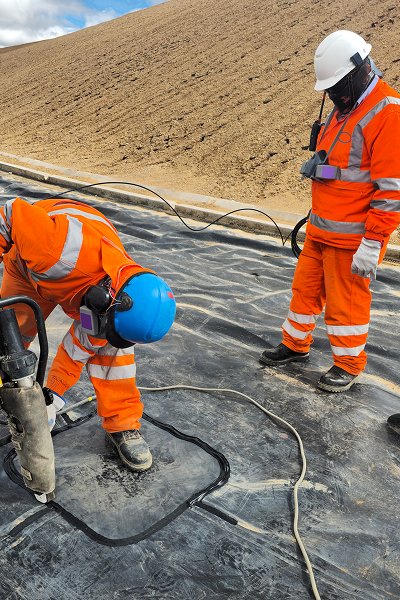The anti-seepage principle of geomembrane
The principle of polymer structure density
Geomembrane is mainly made of polymers (such as HDPE, LLDPE, PVC), whose molecules are tightly arranged, porosity is close to zero, and has an extremely low permeability coefficient (<1.0×10⁻¹⁴ cm/s), which can almost completely prevent the passage of liquid, water vapor or gas.
The non-polar structure of HDPE geomembrane makes it extremely strong in isolating against water and most chemicals;
The molecular chains are densely arranged, which improves the shielding performance of the overall material.


Functional advantages of geomembranes
Extremely low permeability
The permeability coefficient is generally less than 1.0×10⁻¹⁴ cm/s;
It can effectively block a variety of media such as water, oil, and solutions;
It is suitable for landfills, sewage pools, and other places where the leachate contains heavy metals and toxic substances.
Excellent chemical stability
Highly stable to acids, alkalis, salts and most organic solvents;
Not easy to hydrolyze, corrode or decompose;
Suitable for long-term contact with highly corrosive substances.
Excellent anti-aging and weather resistance
HDPE film can maintain stable performance under ultraviolet rays, oxidation, high and low temperature alternation;
The service life can be up to more than 50 years, suitable for use in open-air environments;
Anti-UV agents and antioxidants can be added to enhance stability.
High strength and toughness
High tensile strength and large elongation, adapt to micro-deformation of the foundation;
Good puncture resistance and tear resistance, suitable for complex terrain and piled structures;
Can withstand large loads and stress concentration.


Structural level of anti-seepage system
Solid Waste
It is the main component of the entire landfill;
It contains various urban solid waste;
It will release a large amount of leachate and gas.
Leachate Collection Layer
Material: Gravel layer with controlled particle size (or plastic drainage net/drainage board);
Function: quickly collect and drain the leachate to the collection system;
The thickness is generally 30cm~50cm;
It needs to be used with HDPE geomembrane to prevent puncture.
Geotextile filtration protection layer
Function:
Filter gravel particles to prevent them from clogging the drainage layer;
Buffer and protect the lower geomembrane to prevent puncture;
The gram weight is generally 200g/m²~600g/m².
Geomembrane - HDPE geomembrane
Material: High-density polyethylene (HDPE), usually 1.5mm or 2.0mm thick;
Function: As the main anti-seepage barrier, effectively isolate the leachate;
Hot-melt welding to ensure seamless closure;
It is the "core" of the anti-seepage system.
Bentonite anti-seepage pad (GCL) or compacted clay layer
Two common options:
GCL (bentonite pad): industrialized product, absorbs water and expands to form a low permeability layer;
Compacted clay layer: natural clay compaction layer, usually 0.5m to 1m thick;
Function: Form a second anti-seepage barrier to prevent liquid from seeping in when the membrane breaks and fails;
The permeability coefficient is less than 1×10⁻⁷ cm/s.
Subgrade
Level and compact the site;
As the bearing platform of the entire anti-seepage system;
The foundation stability is directly related to the deformation and life of the anti-seepage system.

Common construction problems
| Issue Type | Possible Cause | Solution |
|---|---|---|
| Cold Weld Seam | Insufficient temperature or damp surface | Clean the surface and re-weld according to standards |
| Burn-Through Seam | Overheating | Reduce temperature and control travel speed |
| Edge Damage | Rough handling or lack of cushioning | Use soft pads for protection; assist manually during placement |
| Missed Weld in Rain | Moisture on material surface | Stop work; re-weld after drying |
The anti-seepage safety of landfills is related to the ecological environment and the health of residents. As the "last line of defense" of the anti-seepage system, the selection and construction of geomembranes must be rigorous and professional. Through scientific design, standardized construction and effective monitoring, leachate leakage can be effectively prevented to achieve the goals of environmental protection and sustainable development.


